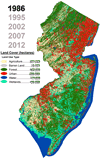|
New Jersey is the most densely populated state in the nation. One of the consequences of this distinction is the extreme pressure that is placed on our natural resources. As the population grows, we continue to lose or impact the remaining natural areas of the state. As more and more habitat has been lost, people have also gained a greater understanding of and appreciation for the benefits and necessity of conserving the natural ecosystems of the state.
For example, we know that wetlands are critical for recharging aquifers, lessening the damage from flooding and naturally breaking down contaminants in the environment. Forests and grasslands protect the quality of our drinking water, help purify the air we breathe and provide important areas for outdoor recreation. Collectively, these habitats are of critical importance to the diverse assemblage of wildlife found in New Jersey, including endangered, threatened and special concern species.
Many imperiled species require large contiguous tracts of habitat for survival. The consequence of the rapid spread of suburban sprawl is the loss and fragmentation of important wildlife habitat and the isolation and degradation of the smaller habitat patches that remain. Small patches of fields, forests and wetlands interspersed with development provide habitat for common species that do well living near humans, but do not provide the necessary habitat for most of our imperiled wildlife. We need to conserve large, contiguous blocks of forests, grasslands and wetlands to assure the survival of imperiled species over the long-term.
|
Land Use/Land Cover
1986 - 2012

New Jersey's landscape is rapidly changing. In the 1986 - 2007 period, urbanization resulted in the loss of approximately 5,000 hectares of wildlife habitat per year.
Click image to enlarge
|

